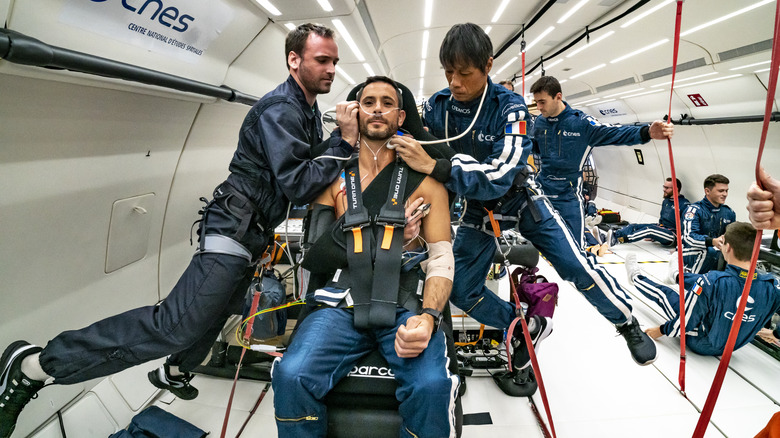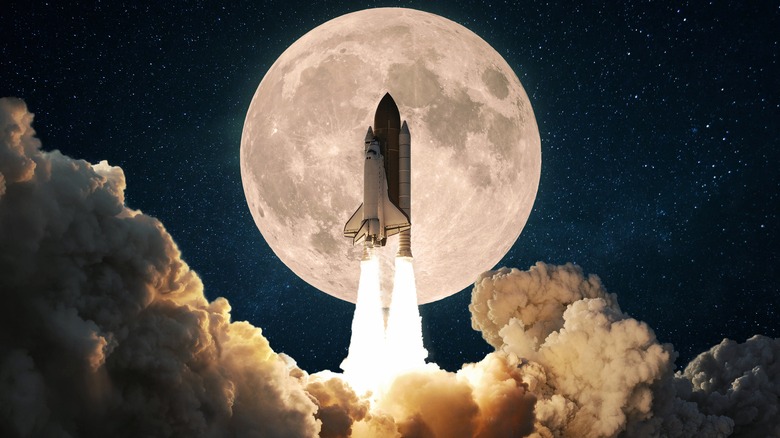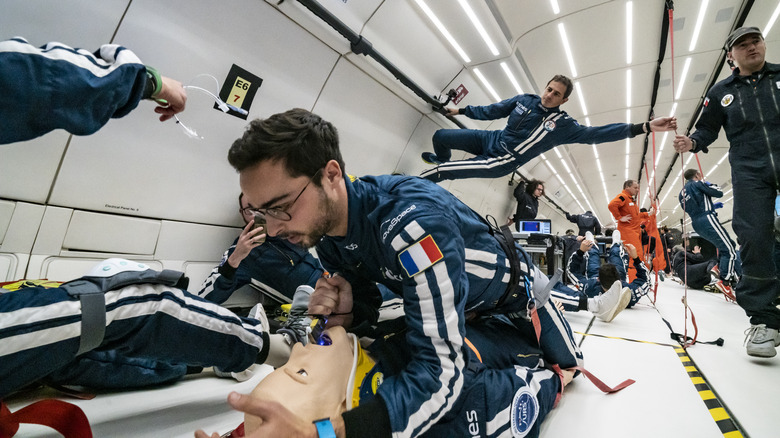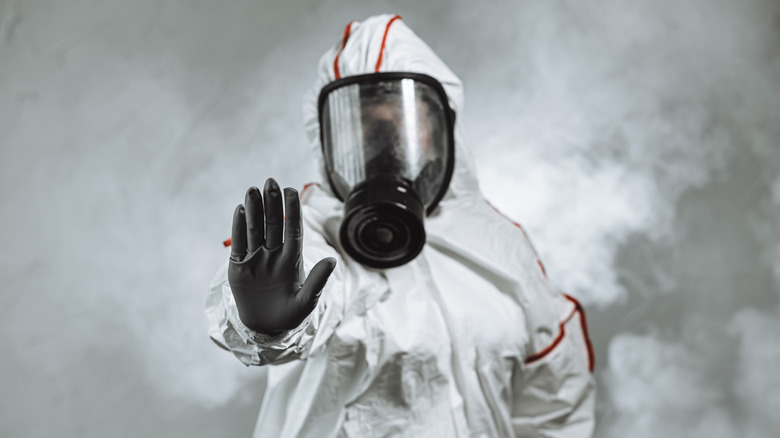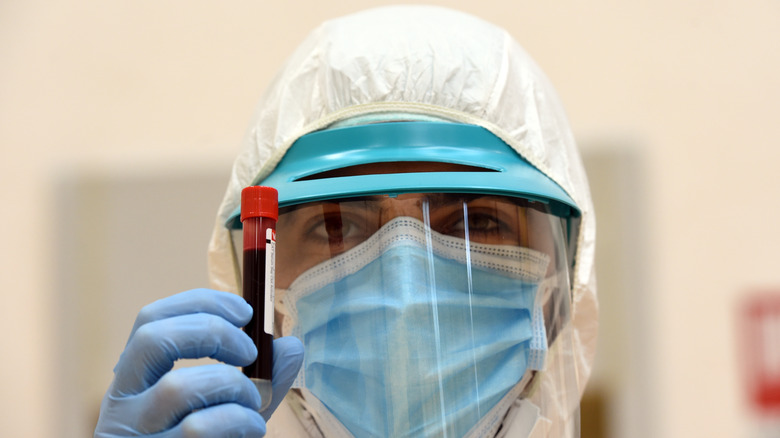Bleeding In Space Is Even Scarier Than We Thought
In space, there are no guarantees. Our limited knowledge of the universe means that every expedition is truly a trip into the unknown. What is that swirling around an astronaut's helmet? Is it a dying star collapsing into itself, a gaping black hole taking prisoners, a possible alien lifeform, or a pocket of utter nothingness? Nobody can say for sure. According to Mental Floss, even very basic tasks in space are marked with a certain degree of uncertainty. Tooth brushing is tricky, and nail clipping can be an eye-piercing experience, literally.
Indeed, if our recent calculations are correct, there's really only one thing an aspiring space cadet can really set their sights on — one thing they're almost guaranteed to see. According to ScienceDirect, it isn't a nebula or an icy ring circling Saturn. No, it's blood. Large volumes of gushing, crimson, cosmic hemoglobin. We're not talking about the tame kind of earthly blood you saw on the latest episode of "Grey's Anatomy" here. This is space blood, and it's every bit as chilling as it sounds.
Blood flows differently and sometimes even backward in space
To say you're more susceptible to injury at zero gravity is putting things lightly (via Wired). As soon as an astronaut touches down in outer space, physical changes occur in the body that affect the cardiovascular system in a myriad of ways. On earth, blood vessels dilate in order to increase their supply, and they constrict in order to prevent us from losing too much blood (per Health Pages). In space, the body finds both of these tasks difficult, which leads to a decreased supply of circulating blood throughout the body, not to mention a decline in red cell mass, a compromised immune system, and a decrease in the amount of time it takes the body to heal itself from gaping wounds.
This physical reaction to zero gravity puts a great deal of pressure on free-floating astronauts, giving them an increased risk of sustaining an injury. Stranger still, in 2019, New Scientist reported the discovery that microgravity can actually make an astronaut's blood run backward through the veins, a conundrum some scientists believe is caused by vital organs rearranging in the chest — yikes! In the 2019 example, two astronauts with backward-flowing blood experienced life-threatening blood clots, but both survived.
So even when human blood is contained in the vast reaches of outer space, it's still pretty scary. Now imagine the impact of an actual wound.
Space blood rockets out of gaping wounds, splattering like a sci-fi slasher
Even though you have less blood in space, it does a whole lot more gushing and splattering when there's no gravity to keep it flowing down. A simple abrasion can give way to a rupture of that cosmic hemoglobin mentioned earlier. Wired reports that if said eruption is messy enough, the splattering blood can cover the entry point of the wound, making it impossible to find, let alone treat.
From this perspective, when you bleed in space, you have less blood in your body, and you lose more of it. Your body is already a flailing potato sack of rearranged organs (per New Scientist), and your immune system is pretty much shot to the moon. Treating external wounds is no walk in the park, but things really get tricky if internal bleeding takes place because creating the external pressure needed to treat an internal hemorrhage is almost impossible under the circumstances (via the Journal of Trauma Management & Outcomes).
On the vomit comet, medical equipment goes haywire
As you might imagine, the details of how to treat wounds at zero gravity aren't exactly easy to pin down. This is why, back in 1959, NASA introduced the Vomit Comet, a free-floating space simulation that makes tons of aspiring astronauts lose their lunch each year (via Live Science). In more recent times, the nausea-inducing capsule has been used to perform all sorts of hypothetical space operations, a prelude to the real thing. The results are pretty terrifying.
According to Wired, blood and medical equipment are difficult to control in a weightless environment, where prescription drugs are rendered unusable if exposed to the air and the bubbles in IV tubes float aimlessly in the wrong direction. Smithsonian Magazine reports that because stuff is generally messier in space, floating debris from skin grafts, bodily waste, and afternoon lunch make for an unhygienic operating room if ever there was one. Some space scientists think the key to combatting this is laparoscopy, a sophisticated technique that involves intentionally placing miniature tools inside the body.
One might only imagine the prospect of being strapped to an operating table at zero-g with an IV that could cause an embolism at any given moment because the bubbles are floating haphazardly — all with a cardiovascular system that's completely off-kilter and blood that is possibly flowing backward — only to have tiny microscopic tools inserted underneath the skin of your gaping wound.
Contamination from bleeding is another looming threat to space flights
In addition to spouting blood posing all sorts of possible hazards — from blood clots to concealed wounds to death from losing too much blood at once — The Atlantic reports that bleeding on a spaceship can also contaminate the cabin. Given the unpredictable way in which blood spews at zero-G, the potential for a gory crimson invasion — not of alien intruders but of astronaut blood — leaves a lot of space for disasters.
According to the CDC, blood droplets left on surfaces can contaminate a confined area for days, even weeks, making it possible for bloodborne diseases to infect the entire crew. Additionally, atmospheric changes almost always weaken the immune systems of human beings who venture into that final frontier (via Space.com). To avoid the bleak circumstance of contaminating the crew with splattered, dried-up blood, Carnegie Mellon researchers teamed up with the University of Louisville to create a domed box that, when positioned over the wound, would disperse a saline sealant that works like a Band-Aid to prevent the laceration from leaking at the trauma site. All of this is quite fascinating but also somewhat eerily reminiscent of the mysterious box of pain in "Dune."
Saving the blood for later is the final step
If you can't think of anything more vile than bleeding in space, consider this: Once it's all said and done, and the mysterious domed boxes and microscopic tools have been inserted, and the splatter-fest of bleeding in space is apparently over, there's one last thing that has to be done — blood collecting. According to The Atlantic, because there are no blood banks available in space, the most logical thing to do after an injury is to collect all the blood from the injured astronaut and store it for future use.
Transfusion News reports that "floating blood banks" sustained by crew member donations could be the wave of the future for astronauts. Such blood banks already exist on the ground, mainly on cruise ships and in combat zones, but the risks of taking these blood banks into outer space might just be astronomical. Perhaps space voyagers of the past had the right idea. In the '90s, they didn't even attempt to operate on small cuts at zero gravity. Harry Whelan of the Medical College of Wisconsin said in a 1999 interview (via Space Daily), "Minor injuries typically don't heal until they land."

